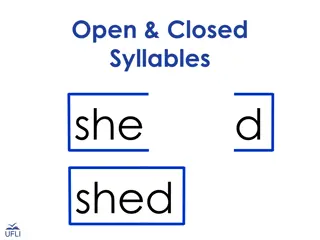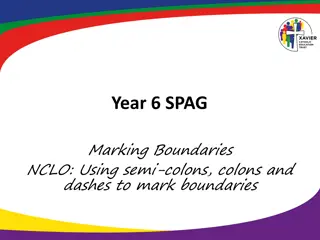Closed and Semi-Closed Castrations Techniques in Veterinary Surgery
Detailed instructions and images depicting the methodology for performing closed and semi-closed castrations in animals under general anesthesia. The closed technique involves incising the scrotum and ligating the spermatic cord, while the semi-closed method involves extruding the testicle and ligating blood vessels and the vaginal process. Advantages include reduced risk of herniation and infection, but disadvantages include increased surgical time and potential complications. An alternative to using an emasculator is also presented.
Download Presentation

Please find below an Image/Link to download the presentation.
The content on the website is provided AS IS for your information and personal use only. It may not be sold, licensed, or shared on other websites without obtaining consent from the author.If you encounter any issues during the download, it is possible that the publisher has removed the file from their server.
You are allowed to download the files provided on this website for personal or commercial use, subject to the condition that they are used lawfully. All files are the property of their respective owners.
The content on the website is provided AS IS for your information and personal use only. It may not be sold, licensed, or shared on other websites without obtaining consent from the author.
E N D
Presentation Transcript
Closed and Semi-Closed Castrations Performed under GA
The Methodology for Closed Castrations: 1. Incise the scrotum longitudinally (approximately 4 cm from the median raphe. Or by making 2 parallel incisions 8-10 cm long about 2cm from the median raphe then connecting the inscions cranially and caudally then removing the scrotal skin between the incision. Cut the through the skin and tunica dartos. Using blunt dissection, free the the parietal tunic surrounding the testis from the scrotal ligament and scrotal fascia. Placing mild traction on the testis with one hand. With the other hand separate the the vaginal tunic surrounding the cord from fascia surrounding the spermatic cord Ensure that the pudendal vessels are separated with the fascia. Ligate the spermatic cord using 5 metric absorbable suture (eg PDS), anchoring the ligature in the external cremaster muscle. Use an emasculator to cut approximately 2 cm below the ligature. The emasculator is placed on the cord as proximally and transversely as possible (in the nut to nut configuration) Crush for 30 seconds to 4 minutes then place a haemostat on the cord before releasing the emasculator 2. 3. 4. 5. 6. 7. 8.
Methodology for Semi-Closed Castrations: Very similar to the CLOSED TECHNIQUE wrt to incision and blunt direction of the spermatic sac 1. Incise the vaginal tunic cranial to and above the testicle. *** 2. Extrude the testicle. 3. Ligate the spermatic blood vessels 4. Ligate the vaginal process. 5. Use an emasculator (in the nut to nut configuration) to remove the testicle and epididymis (contained in the distal portion of the vaginal process). ***The difference between the closed and semi-closed methods
Advantages and Disadvantages Advantages: Ligation prevents herniation and infection as the peritoneal cavity is sealed It is possible to close the scrotal skin to facilitate rapid healing but it is often left open for drainage purposes Disadvantages: Increased surgical and anaesthesia time increases the risk for complications Leaving a ligature behind may cause irritation and inflammation
Alternative to using an emasculator The Henderson castrating tool can be used together with a variable speed cordless drill. The pliers of the tool are clamped onto the entire spermatic cord just proximal to the testis. with one hand supporting the testis. Apply slight tension on the drill and rotate slowly while gradually increasing the speed until the cord is severed (it takes about 15 - 20 rotations) The twisted cord seals the blood vessels and the parietal tunic thus preventing bleeding and herniation.
Some youtube demos (some videos are linked to the topics discussed in Pre-Operative Care ) Demonstration of the Henderson s castrating technique: https://www.youtube.com/watch?v=ST6MlD3JVS0&t=176s Equine Equine Veterinarian Dr. Jenni Does A Complete Castration of a Miniature Horse https://www.youtube.com/watch?v=6uXKIRh7DoU (begins at 1 minute 50 seconds) Star patient: Buddy https://www.youtube.com/watch?v=L9hIafZBvvM Equine (Horse) Castration: https://www.youtube.com/watch?v=MqkzoYnmWJk
References: Auer J. Equine surgery. 5th ed. St. Louis: Elsevier; 2019. Turner A, McIlwraith C, Hull B. Techniques in large animal surgery. 4th ed. Philadelphia (Pa.): Lippincott Williams & Wilkins; 2013.























